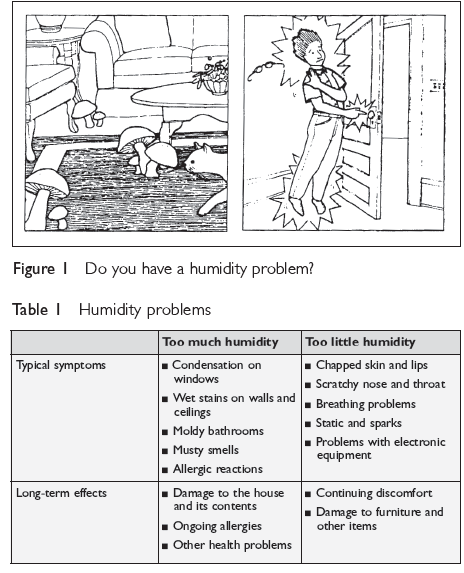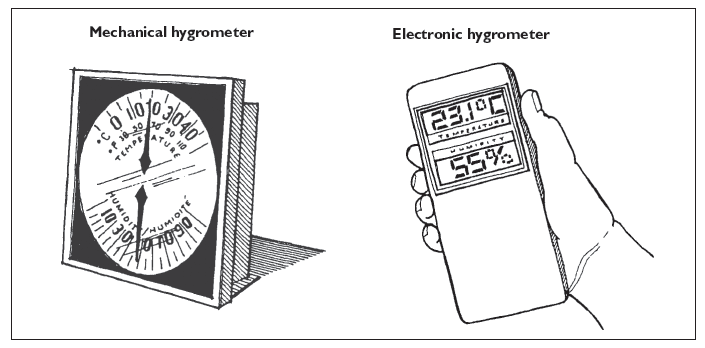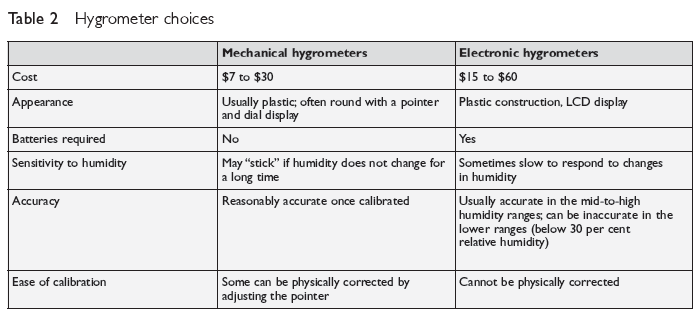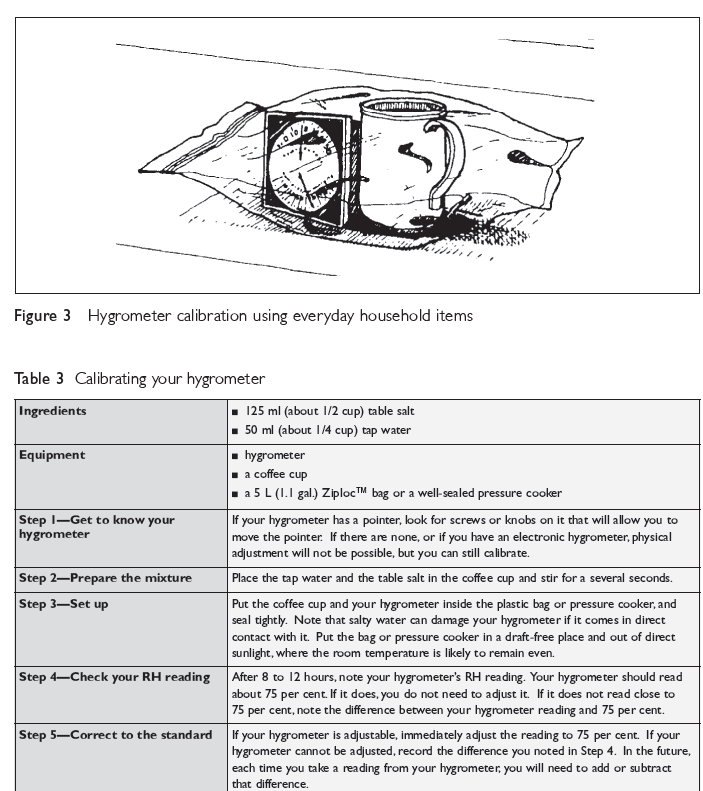Measuring Humidity in Your Home
Straight Facts About Humidity
(CMHC - About Your Home Fact Sheet)Humidity is the amount of moisture or water vapour in the air. You, your family, and your pets produce moisture when you breathe or perspire. Even your indoor plants produce moisture. We add water vapour to indoor air through routine household activities: cooking, showering, bathing, doing laundry, and dishwashing. More moisture can enter your home from the surrounding soil through a basement or crawl space.
When is Humidity a Problem?
We need humidity for our comfort and health. But too much or too little humidity can produce a host of difficulties for householders (see Table 1). Some of the problems are no more than nuisances; others could be far more serious. Many are familiar to Canadians. They often occur during the heating season when our windows are closed and indoor air circulation and ventilation are reduced.

Diagnosing a Humidity Problem
Instead of guessing whether or not you have a humidity problem inside your house, why not find out for sure? A small, inexpensive and easy-to-use instrument called a hygrometer (sometimes referred to as a humidity
sensor or relative humidity indicator) can measure the humidity level in your house and confirm whether the house has too much or too little humidity. Once you know for sure, you can decide whether any action is required and, if so, what action.
Relative humidity
Humidity is normally measured as relative humidity (RH). RH is a percentage that indicates the amount of moisture in the air relative to the maximum amount the air can hold at that temperature. For instance, when air at a given temperature contains all the water vapour it can hold at that temperature, it has a RH of 100 per cent. If the humidity exceeds 100 per cent, moisture will begin to condense from the air. If the air contains only half the water it can hold at that temperature, the RH is 50 per cent.
Warm air can hold more moisture than cool air, so that the RH of a sample of air will change as the temperature changes, even though the actual amount of moisture in the sample air does not. For example, as a sample of air cools the RH rises.
Buying a hygrometer
The two types of hygrometers that are most suitable for household use are mechanical hygrometers and electronic hygrometers. Table 2 highlights important characteristics of each type. For most households, either type will perform satisfactorily if properly used and calibrated. See “Getting accurate readings” for information about calibration.
Hardware stores, department stores, building supply stores and electronics stores often carry hygrometers. In fact, hygrometers are usually sold wherever you would buy a room thermometer. Hygrometers and room
thermometers are often combined into a single piece of equipment.


Using your hygrometer
Your hygrometer will show the relative humidity (RH) in your house. Although the RH will not be exactly the same throughout your home, one hygrometer per house is usually sufficient. You should place it where the humidity symptoms are most obvious, in the room that you are most concerned about, or where your family spends the most time. Because hygrometers are small, they can be moved around in your house from time to time.
Don’t place your hygrometer near a radiator, a heat register, a chimney or in any other location where it could be affected by direct heat.
Remember that a hygrometer does not produce instant results. It may take up to two hours to provide a stable reading in a new location or to adjust to sudden changes in relative humidity.
Getting accurate readings
You should make sure that your hygrometer provides accurate readings. The technical term for this is calibration. When you calibrate your hygrometer, you are testing its accuracy by comparing it with an independent
standard.
Calibration made simple
All hygrometers should be calibrated. Some are not properly set when they leave the factory. Others, even the best models on the market, may experience what is known as drift, which means that they do not hold their accuracy over long periods and need to be re-calibrated.
Calibration is easy. A step-by-step procedure using everyday household items is described in Table 3. The basic principle is to create a small-scale environment where the relative humidity is known. You place your hygrometer in this environment and compare its reading to the known humidity level.
How often should you calibrate?
Once you have calibrated your hygrometer, you can be confident that you are getting accurate readings. Even so, you should re-calibrate your hygrometer once a year, especially if it is a mechanical instrument, to make
sure that it continues to work properly.

Humidity: How Much is Too Much? How Much is Too Little?
Experts have developed rules of thumb to help homeowners make decisions regarding humidity levels in their house. The limits should be used as guides only. Acceptable or comfortable humidity levels will actually vary from season to season, from house to house, and even between rooms in the same house.
Rules of thumb
To prevent window condensation during the heating season, the recommended indoor RH is 30 per cent to 50 per cent. When it is below -10°C (14°F) outdoors, recommended indoor RH is 30 per cent.
Taking Action
Humidity can be controlled. If the relative humidity in your home is too high, you can reduce it; if it is too low, you can increase it.
In summer, you can reduce house humidity levels by the use of a dehumidifier (see the About Your House fact sheet Choosing a Dehumidifier) or by running an air conditioner.
In winter, a house that is too wet usually has some high moisture sources (for example, a damp basement, roof leaks, many plants). Deal with these problems first. If high humidity persists, you may need to make simple changes in your family’s habits, such as remembering to open or close doors or windows. Or, you can install equipment, such as exhaust fans in bathrooms or a heat recovery ventilator (HRV), to remove excess
humidity.
Very low indoor RH levels in the winter may result from cold, dry air leaking in from outside. In this case, sealing up the house by weatherstripping and caulking will improve humidity conditions indoors and may reduce your heating bills at the same time.
If low humidity problems persist, despite airtightening the house, consider the use of a humidifier. Humidifiers—both stand-alone humidifiers and humidifiers attached to your furnace—will increase i ndoor RH levels. But if they are not installed, used and maintained properly, they can also be sources of excess moisture and mold in your home.
Final Analysis
Humidity levels in your home can be too high or too low. In either case, problems can result. A hygrometer can provide the information you need to determine whether you have a humidity problem—but it must be accurate to be useful. If you have a humidity problem, it can usually be controlled.
